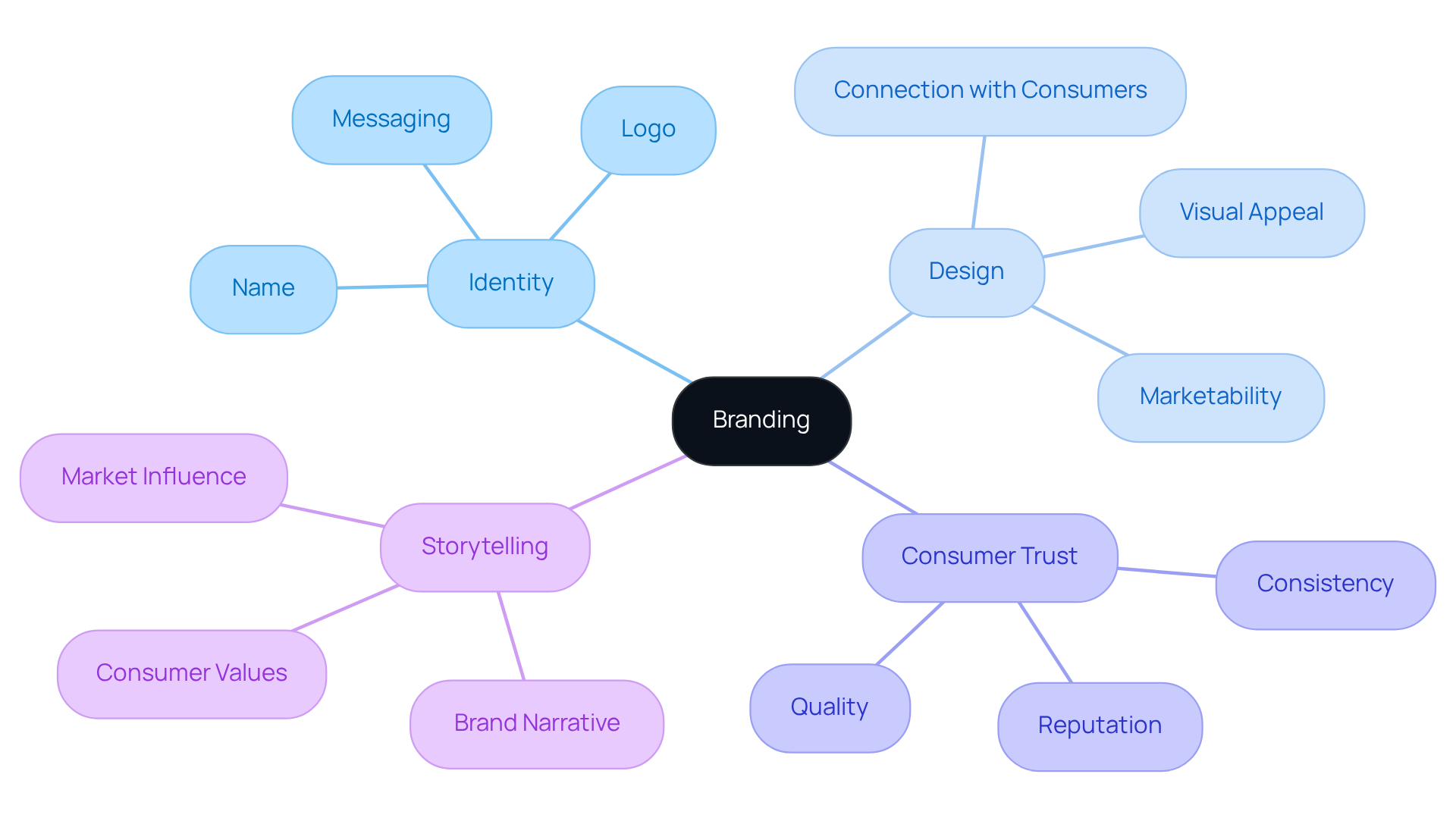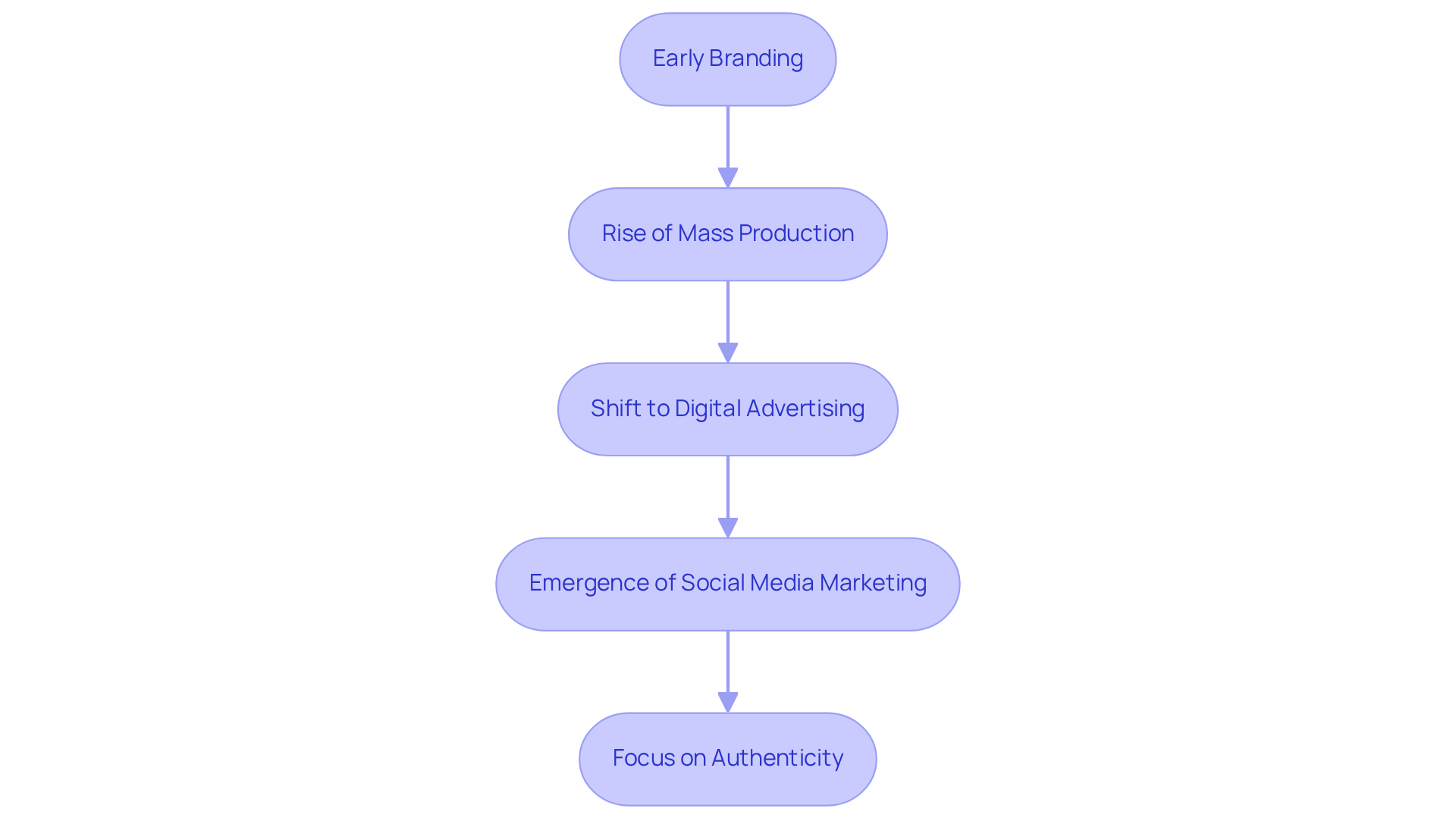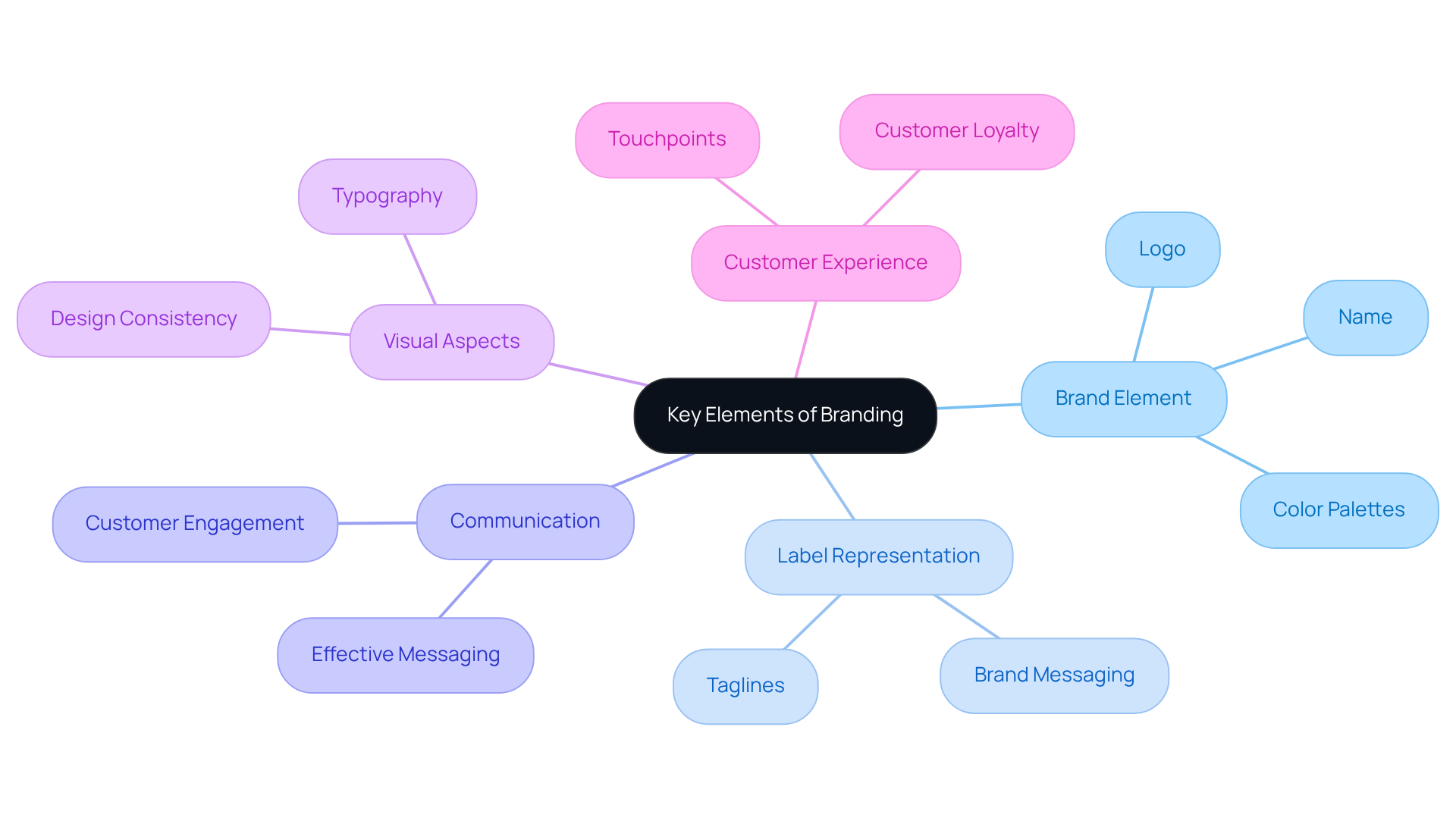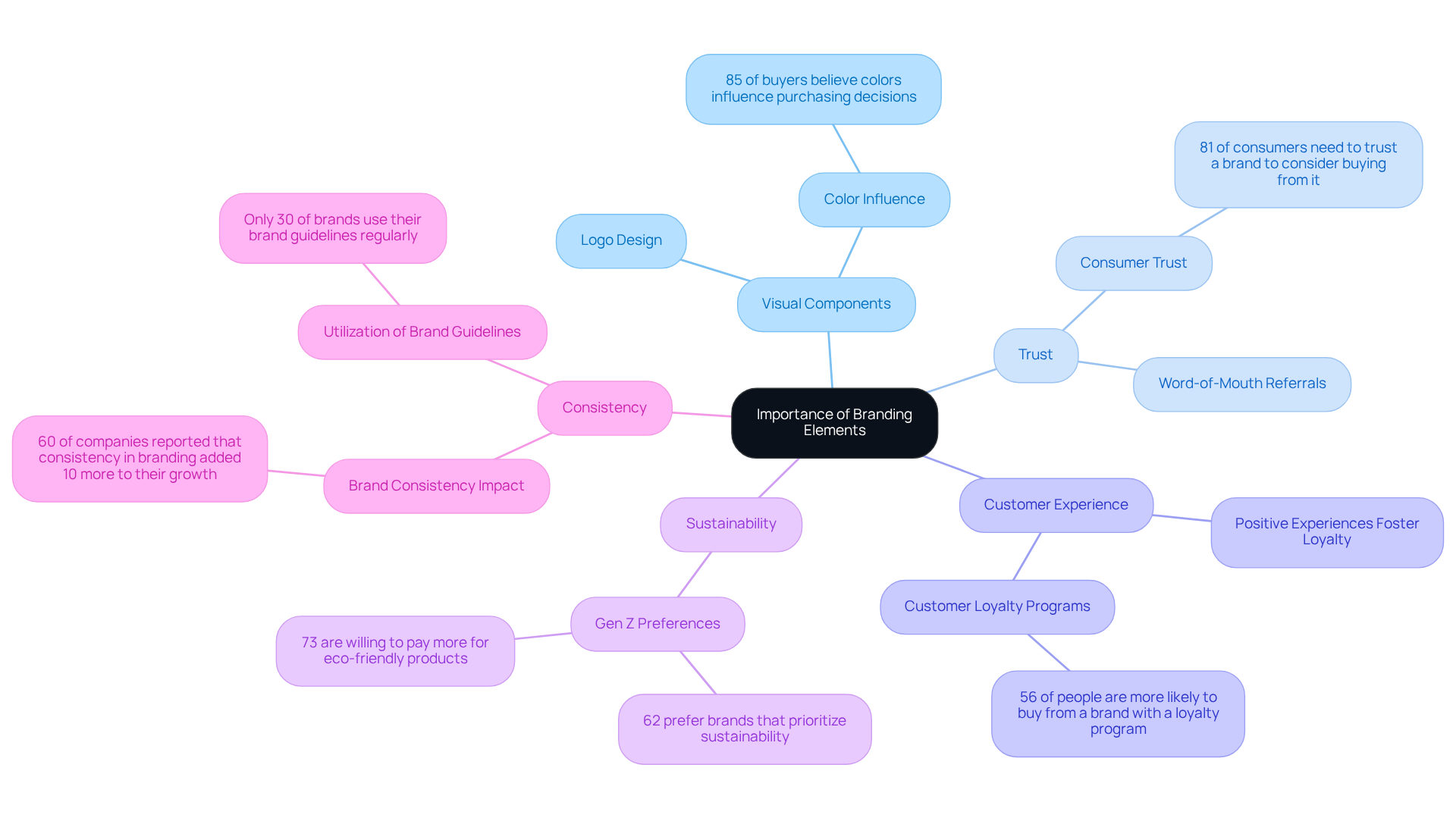Overview
For tech startups, the challenge of crafting a unique identity that truly resonates with consumers can feel overwhelming. This identity encompasses vital elements such as:
- Design
- Messaging
- Customer experience
The implications of not having a strong brand identity are significant; without it, credibility and trust may wane, leaving startups struggling to forge meaningful connections with their audience. These connections are essential for long-term success in a competitive market. However, there is hope. By focusing on creating a strong brand identity, tech startups can enhance their credibility, build trust, and foster those vital relationships with consumers. This nurturing approach not only addresses the emotional needs of founders but also paves the way for sustainable growth and success.
Introduction
Branding is more than just a visual representation; it is the lifeblood of tech startups striving to carve out their niche in an increasingly competitive digital landscape. Many founders find themselves grappling with the daunting challenge of creating a distinctive identity. This struggle can lead to feelings of frustration and uncertainty, as the need to establish credibility and foster consumer trust weighs heavily on their shoulders.
How can startups effectively navigate the complexities of brand development? It’s crucial to not only stand out but also resonate with your target audience.
At RNO1, we understand these challenges deeply. We recognize that the journey of building a brand can be overwhelming, but you are not alone. By embracing the core elements of branding, you can create a powerful identity that speaks to your audience. Our approach is rooted in empathy, and we are here to support you every step of the way. Together, we can transform your vision into a brand that not only captures attention but also builds lasting relationships with your customers.
Define Branding: Understanding Its Core Concept
Branding is a challenging development for many , as they must find a way to create a unique character that stands out in a crowded market. This process is not just about aesthetics; it’s about creating an identity that resonates with consumers on a deeper level. The element of brand, including the name, logo, design, messaging, and overall perception, is crucial. Without a , establishing credibility and fostering trust among potential customers can feel daunting. A well-crafted identity communicates its value proposition clearly, making it a cornerstone of any successful business strategy.
At RNO1, we understand that design is at the heart of branding. Our commitment to means that every touchpoint and interaction is thoughtfully crafted to enhance marketability through our Return On Design & Digital (RODD) strategies. This focus on design transcends mere visual appeal; it’s about forging a meaningful connection with consumers that positively influences their perception of the company.
The impact of branding on consumer trust is profound. As industry experts remind us, a label is akin to a reputation; it is earned through consistent quality and reliability. Jeff Bezos eloquently states, '. You earn reputation by trying to do hard things well.' This underscores the importance of a as an element of brand in significantly enhancing a startup's credibility in a competitive landscape.
Moreover, successful for technology companies often weave in storytelling that resonates with consumer values and expectations. David Brier wisely notes, ', they’ll define your brand’s story for you.' This highlights the necessity for startups to actively shape their narrative, ensuring a positive image and building trust.
In summary, the element of extends beyond visual representation; it is about establishing a reliable presence that connects with consumers. By nurturing this connection, tech startups can pave the way for long-term success in the industry.

Explore the Evolution of Branding: A Historical Perspective
Branding has evolved significantly from its early days, where it primarily functioned as an element of brand identification for products. Today, particularly in the tech sector, startups face the challenge of standing out in a landscape increasingly shaped by digital interactions. The 20th century marked a pivotal shift with the rise of mass production and advertising, which transformed the into a strategic tool for differentiation.
As we navigate this complex environment, the rise of social media and online platforms has shifted our focus from traditional marketing methods to digital promotion, where engagement and interaction are paramount. In fact, 74% of global marketers now prioritize to enhance visibility, recognizing its critical role in establishing identity. This reality compels technology enterprises to adapt their , recognizing the element of brand necessary to remain competitive in a fast-paced market.
Historical milestones, such as the shift from print to , underscore the necessity for companies to embrace innovation and authenticity. In a world filled with noise and conflicting messages, authenticity emerges as an essential element of brand, making it crucial for tech startups to cultivate genuine connections with their audience. This shift reflects changing and emphasizes the significance of a that resonates across digital platforms.
At RNO1, we understand that branding is not merely about visibility; it’s about fostering through . Our commitment to a ensures that every touchpoint connects with the target audience, enhancing marketability through our Return On Design & Digital (RODD) strategies. This commitment is exemplified in our strategic rebranding of Founder's Haven, where we empowered modern founders to achieve by enhancing their image and user experience.

Identify Key Elements of Branding: A Comprehensive Breakdown
Establishing a strong can feel overwhelming for many tech startup founders. The challenge often lies in the myriad of components that make up , such as:
- The element of brand
- Label representation
- Communication
- Visual aspects
It's important to recognize that brand identity encompasses the name, logo, and overall aesthetic that signify your new venture. This identity creates an initial impression, which studies show can be formed in just 50 milliseconds. This fleeting moment is crucial, as over 94% of . It’s a daunting statistic, but understanding its significance can empower you.
is another essential element. It conveys your startup's values and mission, resonating deeply with your target audience and fostering trust. In fact, 81% of consumers need to trust a company before they even consider making a purchase. This highlights , which is essential for your startup's success.
, such as , play a significant role in crafting a memorable identity. Studies indicate that by as much as 80%. Imagine the impact of a well-thought-out color scheme that not only represents your brand but also evokes the right emotions in your audience.
Finally, customer experience encompasses every interaction a customer has with your company. Each touchpoint significantly influences their perception and loyalty. A strong brand can even decrease hiring and training expenses by as much as 50%, illustrating the long-term advantages of a unified marketing strategy. By nurturing these elements of brand, you can create a comprehensive marketing strategy that profoundly influences your technology company's success. Remember, you are not alone in this journey; there are effective examples and supportive resources available to guide you along the way.

Analyze the Importance of Each Branding Element: Building a Cohesive Identity
Creating a unified presence can feel overwhelming for technology businesses. Without a well-defined element of brand, gaining recognition and establishing trust with consumers becomes challenging. At RNO1, we understand these struggles, and that’s why we embrace a . We believe that is essential to articulate your startup's , especially in a crowded market.
By enhancing and color schemes, we help improve memorability and evoke emotional responses that are vital for recognition. Research shows that 85% of buyers believe colors influence their purchasing decisions, highlighting just how important is. Moreover, we recognize that a positive is crucial for fostering loyalty; after all, 81% of consumers need to before considering a purchase. This trust is the foundation for word-of-mouth referrals, which are invaluable for growth.
For instance, 62% of Gen Z consumers prefer companies that prioritize sustainability, and 73% are willing to pay more for eco-friendly products. This underscores the necessity for new ventures to align their principles with customer expectations. Additionally, maintaining consistency across all touchpoints is essential for reinforcing your identity.
By strategically implementing these elements of brand, RNO1 is here to support you in forging a that resonates with your audience. Together, we can help you stand out in a competitive landscape, maximizing your marketability through our Return On Design & Digital (RODD) strategies.

Conclusion
Establishing a strong brand identity can often feel like a daunting challenge for tech startups navigating a competitive landscape. It's important to recognize that branding is not just about visuals; it’s about forging a meaningful identity that truly resonates with consumers and fosters their trust. By paying attention to the essential elements of branding—like design, messaging, and customer experience—startups can significantly enhance their market presence and build credibility.
Throughout this journey, we’ve highlighted the critical importance of a well-defined brand identity. Consider the role of design in shaping first impressions; it can make or break a potential relationship with a customer. Similarly, effective messaging that reflects consumer values is essential. Each of these elements plays a vital role in creating a cohesive and trustworthy brand. The historical evolution of branding reminds us that innovation and authenticity are more crucial than ever in today’s digital age, where consumer expectations are ever-changing.
Ultimately, we encourage tech startups to embrace a strategic approach to branding that prioritizes connection and authenticity. By doing so, they can not only stand out in a crowded market but also cultivate meaningful, lasting relationships with their audience. The significance of a strong brand identity cannot be overstated; it is a vital component that can propel a startup toward long-term success and sustainability in the ever-evolving tech industry. We are here to support you in this journey, helping you navigate the complexities of branding with compassion and expertise.
Frequently Asked Questions
What is branding and why is it important for tech startups?
Branding is the process of creating a unique identity that stands out in a crowded market. It is crucial for tech startups as it establishes credibility and fosters trust among potential customers through a well-crafted identity that communicates its value proposition.
What elements are included in branding?
Branding includes elements such as the name, logo, design, messaging, and overall perception of the brand.
How does design play a role in branding?
Design is at the heart of branding, enhancing marketability and forging meaningful connections with consumers. It transcends mere visual appeal and is integral to creating a positive perception of the company.
What impact does branding have on consumer trust?
Branding significantly impacts consumer trust as a strong identity, akin to a reputation, is earned through consistent quality and reliability. A carefully designed identity enhances a startup's credibility in a competitive landscape.
How can storytelling be incorporated into branding strategies for tech companies?
Successful branding strategies often include storytelling that resonates with consumer values and expectations. Startups should actively shape their narrative to ensure a positive image and build trust.
What is the overall message regarding brand identity for tech startups?
Brand identity extends beyond visual representation; it is about establishing a reliable presence that connects with consumers. Nurturing this connection is essential for long-term success in the industry.




